Palivizumab for preventing severe respiratory syncytial virus (RSV) infection in children
- PMID: 34783356
- PMCID: PMC8594174
- DOI: 10.1002/14651858.CD013757.pub2
Palivizumab for preventing severe respiratory syncytial virus (RSV) infection in children
Update in
-
Palivizumab for preventing severe respiratory syncytial virus (RSV) infection in children.Cochrane Database Syst Rev. 2025 Jul 23;7(7):CD013757. doi: 10.1002/14651858.CD013757.pub3. Cochrane Database Syst Rev. 2025. PMID: 40698576 Review.
Abstract
Background: Respiratory viruses are the leading cause of lower respiratory tract infection (LRTI) and hospitalisation in infants and young children. Respiratory syncytial virus (RSV) is the main infectious agent in this population. Palivizumab is administered intramuscularly every month during five months in the first RSV season to prevent serious RSV LRTI in children. Given its high cost, it is essential to know if palivizumab continues to be effective in preventing severe RSV disease in children.
Objectives: To assess the effects of palivizumab for preventing severe RSV infection in children.
Search methods: We searched CENTRAL, MEDLINE, three other databases and two trials registers to 14 October 2021, together with reference checking, citation searching and contact with study authors to identify additional studies. We searched Embase to October 2020, as we did not have access to this database for 2021.
Selection criteria: We included randomised controlled trials (RCTs), including cluster-RCTs, comparing palivizumab given at a dose of 15 mg/kg once a month (maximum five doses) with placebo, no intervention or standard care in children 0 to 24 months of age from both genders, regardless of RSV infection history. DATA COLLECTION AND ANALYSIS: We used Cochrane's Screen4Me workflow to help assess the search results. Two review authors screened studies for selection, assessed risk of bias and extracted data. We used standard Cochrane methods. We used GRADE to assess the certainty of the evidence. The primary outcomes were hospitalisation due to RSV infection, all-cause mortality and adverse events. Secondary outcomes were hospitalisation due to respiratory-related illness, length of hospital stay, RSV infection, number of wheezing days, days of supplemental oxygen, intensive care unit length of stay and mechanical ventilation days.
Main results: We included five studies with a total of 3343 participants. All studies were parallel RCTs, assessing the effects of 15 mg/kg of palivizumab every month up to five months compared to placebo or no intervention in an outpatient setting, although one study also included hospitalised infants. Most of the included studies were conducted in children with a high risk of RSV infection due to comorbidities like bronchopulmonary dysplasia and congenital heart disease. The risk of bias of outcomes across all studies was similar and predominately low. Palivizumab reduces hospitalisation due to RSV infection at two years' follow-up (risk ratio (RR) 0.44, 95% confidence interval (CI) 0.30 to 0.64; 5 studies, 3343 participants; high certainty evidence). Based on 98 hospitalisations per 1000 participants in the placebo group, this corresponds to 43 (29 to 62) per 1000 participants in the palivizumab group. Palivizumab probably results in little to no difference in mortality at two years' follow-up (RR 0.69, 95% CI 0.42 to 1.15; 5 studies, 3343 participants; moderate certainty evidence). Based on 23 deaths per 1000 participants in the placebo group, this corresponds to 16 (10 to 27) per 1000 participants in the palivizumab group. Palivizumab probably results in little to no difference in adverse events at 150 days' follow-up (RR 1.09, 95% CI 0.85 to 1.39; 3 studies, 2831 participants; moderate certainty evidence). Based on 84 cases per 1000 participants in the placebo group, this corresponds to 91 (71 to 117) per 1000 participants in the palivizumab group. Palivizumab probably results in a slight reduction in hospitalisation due to respiratory-related illness at two years' follow-up (RR 0.78, 95% CI 0.62 to 0.97; 5 studies, 3343 participants; moderate certainty evidence). Palivizumab may result in a large reduction in RSV infection at two years' follow-up (RR 0.33, 95% CI 0.20 to 0.55; 3 studies, 554 participants; low certainty evidence). Based on 195 cases of RSV infection per 1000 participants in the placebo group, this corresponds to 64 (39 to 107) per 1000 participants in the palivizumab group. Palivizumab also reduces the number of wheezing days at one year's follow-up (RR 0.39, 95% CI 0.35 to 0.44; 1 study, 429 participants; high certainty evidence).
Authors' conclusions: The available evidence suggests that prophylaxis with palivizumab reduces hospitalisation due to RSV infection and results in little to no difference in mortality or adverse events. Moreover, palivizumab results in a slight reduction in hospitalisation due to respiratory-related illness and may result in a large reduction in RSV infections. Palivizumab also reduces the number of wheezing days. These results may be applicable to children with a high risk of RSV infection due to comorbidities. Further research is needed to establish the effect of palivizumab on children with other comorbidities known as risk factors for severe RSV disease (e.g. immune deficiencies) and other social determinants of the disease, including children living in low- and middle-income countries, tropical regions, children lacking breastfeeding, living in poverty, or members of families in overcrowded situations.
Copyright © 2021 The Cochrane Collaboration. Published by John Wiley & Sons, Ltd.
Conflict of interest statement
LG: declared that they have no conflict of interest. LS: declared that they have no conflict of interest. PR: declared that they have no conflict of interest. CMEL: declared that they have no conflict of interest. IE: declared that they have no conflict of interest. JVAF: declared that they have no conflict of interest.
Figures

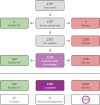
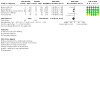
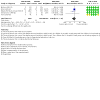
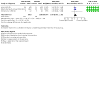

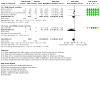

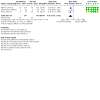




References
References to studies included in this review
Blanken 2013 {published and unpublished data}
-
- Blanken M, Rovers M, Molenaar J, Winkler-Seinstra P, Meijer A, Kimpen J. Respiratory syncytial virus prevention with Palivizumab is associated with a decrease in non-hospitalized RSV infections; 2013 May 4 – 7; Washington, D.C. In: Pediatric Academic Societies Annual Meeting. 2013.
-
- Blanken M, Rovers M, Sanders E, Bont L. Ethical considerations and rationale of the MAKI trial: a multicenter double-blind randomized placebo-controlled trial into the preventive effect of palivizumab on recurrent wheezing associated with respiratory syncytial virus infection in children with a gestational age of 33-35 weeks. Contemporary Clinical Trials 2012;33(6):1287-92. - PubMed
-
- Blanken MO, Rovers MM, Molenaar JM, Winkler-Seinstra PL, Meijer A, Kimpen JL, et al. Respiratory syncytial virus and recurrent wheeze in healthy preterm infants. New England Journal of Medicine 2013;368(19):1791-9. - PubMed
-
- Bont L, Blanken MO, Rovers MM, Molenaar JM, Winkler-Seinstra PL, Meijer A, et al. Causal relationship between respiratory syncytial virus infection and recurrent wheeze during the first year of life. American Journal of Respiratory and Critical Care Medicine 2013;187:A6127.
Feltes 2003 {published data only}
-
- Feltes TF, Cabalka AK, Meissner C, Piazza FM, Carlin DA, Top FH, et al. Palivizumab prophylaxis reduces hospitalization due to respiratory syncytial virus in young children with hemodynamically significant congenital heart disease. Journal of Pediatrics 2003;143(4):532-40. - PubMed
IMpact‐RSV Study Group 1998 {published data only}
-
- The IMpact-RSV Study Group. Palivizumab, a humanized respiratory syncytial virus monoclonal antibody, reduces hospitalization from respiratory syncytial virus infection in high-risk infants. Pediatrics 1998;102(3 Pt 1):531-7. - PubMed
Subramanian 1998 {published data only}
-
- Subramanian K, Weisman L, Rhodes T, Ariagno R, Sanchez PJ, Steichen J, et al. Safety, tolerance and pharmacokinetics of a humanized monoclonal antibody to respiratory syncytial virus in premature infants and infants with bronchopulmonary dysplasia. MEDI-493 Study Group. Pediatric Infectious Disease Journal 1998;17(2):110-5. - PubMed
Tavsu 2014 {published data only}
-
- Tavsu I, Gursoy T, Dirman S, Erbil N, Ovali F. Palivizumab prophylaxis: does It have any influence on the growth and development of the infants? American Journal of Perinatology 2014;31(8):667-71. - PubMed
References to studies excluded from this review
Anonymous 1999 {published data only}
-
- Prevention of respiratory syncytial virus infection by monoclonal antibody. Deutsche Apotheker Zeitung 1999;139(28):36.
Anonymous 2004 {published data only}
-
- Palivizumab: new indication. Moderate reduction in hospitalisation rate. Prescrire International 2004;13(74):213-6. - PubMed
Driver 1999 {published data only}
-
- Driver LC, Oertel MD. Synagis: an anti-RSV monoclonal antibody. Pediatric Nursing 1999;25(5):527-30. - PubMed
EUCTR2007‐002070‐61‐PL {published data only}
-
- EUCTR2007-002070-61-PL. A study to evaluate the safety, tolerability, pharmacokinetics, and immunogenicity of MEDI-524, a humanized enhanced potency monoclonal antibody against respiratory syncytial virus (RSV), in children with hemodynamically significant congenital heart disease. http://www.who.int/trialsearch/Trial2.aspx?TrialID=EUCTR2007-002070-61-PL (first received 10 August 2007).
Ignacio 2013 {published data only}
Johnson 1999 {published data only}
-
- Johnson KE, Weisman LE. Palivizumab (Synagis®) in the prevention of lower respiratory tract infection in children due to respiratory syncytial virus (RSV). Today's Therapeutic Trends 1999;17(3):227-42.
Koganesawa 2019 {published data only}
-
- Koganesawa M, Ono T, Takamido S, Takagi T, Yamaoka D, Ujiie G, et al. Prophylactic palivizumab prevents respiratory syncytial virus infection in pediatric patients with immunodeficiencies. Pediatric Blood & Cancer 2019;66:S39.
Naver 2002 {published data only}
-
- Naver L, Eriksson M, Ewald U, Linde A, Lindroth M, Schollin J. Prophylaxis against RS virus infection [Profylax mot rs-virusinfektion.]. Läkartidningen 2002;99(3):170-1. - PubMed
Pin 2002 {published data only}
-
- Pin I, Pilenko C, Bost M. Prevention of infection by respiratory syncytial virus (VRS) by SYNAGYS® (PALIVIZUMAB). Allergie et Immunologie 2002;34(10):371-4. - PubMed
Rajakumar 2009 {published data only}
-
- Rajakumar D, Tan B, Bodani J, Zhu T, Janzen B, Bodani R et al. Children hospitalized with respiratory syncytial virus (RSV) infection after palivizumab prophylaxis in two large paediatric tertiary care centers. Acta Paediatrica 2009;98:214-5.
Tulloh 2011 {published data only}
-
- Tulloh R, Flanders L, Henderson J, Thompson R, Feltes T. Does RSV infection cause pulmonary hypertension in children undergoing cardiac surgery? Archives of Disease in Childhood 2011;96:A37-8.
References to studies awaiting assessment
EUCTR 2018‐002980‐25‐IT {published data only}
-
- EUCTR 2018-002980-25-IT. Randomized, multicenter, open-label study on PREvention of respiratory SEquelae of RSV bronchiolitis in preterm babies (PRESERV). www.clinicaltrialsregister.eu/ctr-search/trial/2018-002980-25/IT (first received 7 October 2020).
Lenney 1998 {published data only}
-
- Lenney W, Connor E. Humanised monoclonal antibody to respiratory syncytial virus (MEDI-493) significantly reduces the incidence of RSV hospitalisation in at-risk infants. European Respiratory Journal. Supplement 1998;12(Suppl 28):270S.
Additional references
Alansari 2019
Amarasinghe 2019
Andabaka 2013
Anderson 2017
Arms 2008
-
- Arms JL, Ortega H, Reid S. Chronological and clinical characteristics of apnea associated with respiratory syncytial virus infection: a retrospective case series. Clinical Pediatrics 2008;47(9):953-8. - PubMed
Arriola 2019
-
- Arriola CS, Kim L, Langley G, Anderson EJ, Openo K, Martin AM, et al. Estimated burden of community-onset respiratory syncytial virus associated hospitalizations among children aged <2 years in the United States, 2014-15. Journal of the Pediatric Infectious Diseases Society 2019;9(5):587-95. [DOI: 10.1093/jpids/piz087] [PMID: ] - DOI - PMC - PubMed
Atkins 2004
Baxter 2007
-
- Baxter D. Active and passive immunity, vaccine types, excipients and licensing. Occupational Medicine 2007;57(8):552-6. - PubMed
Bont 2016
Boyce 2000
-
- Boyce TG, Mellen BG, Mitchel EF Jr, Wright PF, Griffin MR. Rates of hospitalization for respiratory syncytial virus infection among children in Medicaid. Journal of Pediatrics 2000;137(6):865-70. - PubMed
Brady 2014
-
- Brady MT, Byington CL, Davies HD, Edwards KM, Jackson MA, Maldonado YA, et al, on behalf of American Academy of Pediatrics Committee on Infectious Diseases, American Academy of Pediatrics Bronchiolitis Guidelines Committee. Updated guidance for palivizumab prophylaxis among infants and young children at increased risk of hospitalization for respiratory syncytial virus infection. Pediatrics 2014;134(2):415-20. - PubMed
Caballero 2019
Capizzi 2017
Carbonell‐Estrany 2010
-
- Carbonell-Estrany X, Simões EA, Dagan R, Hall CB, Harris B, Hultquist M, et al. Motavizumab for prophylaxis of respiratory syncytial virus in high-risk children: a noninferiority trial. Pediatrics 2010;125(1):e35-51. - PubMed
Chanock 1957
-
- Chanock R, Roizman B, Myers R. Recovery from infants with respiratory illness of a virus related to chimpanzee coryza agent (CCA). I. Isolation, properties and characterization. American Journal of Hygiene 1957;66(3):281-90. - PubMed
Checchia 2011
-
- Checchia PA, Nalysnyk L, Fernandes AW, Mahadevia PJ, Xu Y, Fahrbach K, et al. Mortality and morbidity among infants at high risk for severe respiratory syncytial virus infection receiving prophylaxis with palivizumab: a systematic literature review and meta-analysis. Pediatric Critical Care Medicine 2011;12(5):580-8. - PubMed
Claydon 2017
Claydon 2019
Collins 2011
Covidence [Computer program]
-
- Covidence. Version accessed 5 May 2020. Melbourne, Australia: Veritas Health Innovation. Available at covidence.org.
Damore 2008
-
- Damore D, Mansbach JM, Clark S, Ramundo M, Camargo CA Jr. Prospective multicenter bronchiolitis study: predicting intensive care unit admissions. Academic Emergency Medicine 2008;15(10):887-94. - PubMed
Domachowske 1999
Esteban 2020
Fauroux 2017
Feldman 2015
-
- Feldman AS, He Y, Moore ML, Hershenson MB, Hartert TV. Toward primary prevention of asthma. Reviewing the evidence for early-life respiratory viral infections as modifiable risk factors to prevent childhood asthma. American Journal of Respiratory and Critical Care Medicine 2015;191(1):34-44. - PMC - PubMed
Fernández 2010
-
- Fernández P, Trenholme A, Abarca K, Griffin MP, Hultquist M, Harris B, et al, on behalf of Motavizumab Study Group. A phase 2, randomized, double-blind safety and pharmacokinetic assessment of respiratory syncytial virus (RSV) prophylaxis with motavizumab and palivizumab administered in the same season. BMC Pediatrics 2010;10:38. - PMC - PubMed
Gálvez 2017
Geoghegan 2017
-
- Geoghegan S, Erviti A, Caballero MT, Vallone F, Zanone SM, Losada JV, et al. Mortality due to respiratory syncytial virus. Burden and risk factors. American Journal of Respiratory and Critical Care Medicine 2017;195(1):96-103. - PubMed
Ginsberg 2018
Goldstein 2018
-
- Goldstein M, Krilov LR, Fergie J, McLaurin KK, Wade SW, Diakun D, et al. Respiratory syncytial virus hospitalizations among U.S. preterm infants compared with term infants before and after the 2014 American Academy of Pediatrics Guidance on Immunoprophylaxis: 2012-2016. American Journal of Perinatology 2018;35(14):1433-42. [PMID: ] - PMC - PubMed
GRADEpro GDT [Computer program]
-
- GRADEpro GDT. Version accessed 13 October 2021. Hamilton (ON): McMaster University (developed by Evidence Prime). Available at gradepro.org.
Griffin 2020
Hacking 2002
-
- Hacking D, Hull J. Respiratory syncytial virus-viral biology and the host response. Journal of Infection 2002;45(1):18-24. - PubMed
Hall 2009
Hall 2013
-
- Hall CB, Weinberg GA, Blumkin AK, Edwards KM, Staat MA, Schultz AF, et al. Respiratory syncytial virus-associated hospitalizations among children less than 24 months of age. Pediatrics 2013;132(2):341-8. - PubMed
Harris 2011
-
- Harris KC, Anis AH, Crosby MC, Cender LM, Potts JE, Human DG. Economic evaluation of palivizumab in children with congenital heart disease: a Canadian perspective. Canadian Journal of Cardiology 2011;27(4):523.e11-5. - PubMed
Hervás 2012
-
- Hervás D, Reina J, Yañez A, Valle JM, Figuerola J, Hervás JA. Epidemiology of hospitalization for acute bronchiolitis in children: differences between RSV and non-RSV bronchiolitis. European Journal of Clinical Microbiology & Infectious Diseases 2012;31(8):1975-81. - PubMed
Higgins 2019a
-
- Higgins JP, Savović J, Page MJ, Elbers RG, Sterne JA. Chapter 8: Assessing risk of bias in a randomized trial. In: Higgins JP, Thomas J, Chandler J, Cumpston M, Li T, Page MJ, Welch VA, editors. Cochrane Handbook for Systematic Reviews of Interventions Version 6.0 (updated July 2019). Cochrane 2019. Available from www.training.cochrane.org/handbook/archive/v6.
Higgins 2019b
-
- Higgins JP, Thomas J, Chandler J, Cumpston M, Li T, Page MJ, Welch VA, editors. Cochrane Handbook for Systematic Reviews of Interventions Version 6.0 (updated July 2019). Cochrane, 2019. Available from www.training.cochrane.org/handbook/archive/v6. - PMC - PubMed
Higgins 2019c
-
- Higgins JP, Eldridge S, Li T. Chapter 23: Including variants on randomized trials. In: Higgins JP, Thomas J, Chandler J, Cumpston M, Li T, Page MJ, Welch VA, editors. Cochrane Handbook for Systematic Reviews of Interventions Version 6.0 (updated July 2019). Cochrane, 2019. Available from www.training.cochrane.org/handbook/archive/v6.
Holberg 1991
-
- Holberg CJ, Wright AL, Martinez FD, Ray CG, Taussig LM, Lebowitz MD. Risk factors for respiratory syncytial virus-associated lower respiratory illnesses in the first year of life. American Journal of Epidemiology 1991;133(11):1135-51. [PMID: ] - PubMed
Jacobino 2018
Johnson 1997
-
- Johnson S, Oliver C, Prince GA, Hemming VG, Pfarr DS, Wang SC, et al. Development of a humanized monoclonal antibody (MEDI-493) with potent in vitro and in vivo activity against respiratory syncytial virus. Journal of Infectious Diseases 1997;176(5):1215-24. - PubMed
Krilov 2020
-
- Krilov LR, Fergie J, Goldstein M, Brannman L. Impact of the 2014 American Academy of Pediatrics Immunoprophylaxis Policy on the rate, severity, and cost of respiratory syncytial virus hospitalizations among preterm infants. American Journal of Perinatology 2020;37(2):174-83. [PMID: ] - PubMed
La Via 2013
-
- La Via WV, Notario GF, Yu XQ, Sharma S, Noertersheuser PA, Robbie GJ. Three monthly doses of palivizumab are not adequate for 5-month protection: a population pharmacokinetic analysis. Pulmonary Pharmacology and Therapeutics 2013;26(6):666-71. - PubMed
Lee 2016
-
- Lee YI, Peng CC, Chiu NC, Huang DT, Huang FY, Chi H. Risk factors associated with death in patients with severe respiratory syncytial virus infection. Journal of Microbiology, Immunology, and Infection 2016;49(5):737-42. - PubMed
Lefebvre 2019
-
- Lefebvre C, Glanville J, Briscoe S, Littlewood A, Marshall C, Metzendorf MI, et al, Cochrane Information Retrieval Methods Group. Chapter 4: Searching for and selecting studies. In: Higgins JP, Thomas J, Chandler J, Cumpston M, Li T, Page MJ, Welch VA, editors. Cochrane Handbook for Systematic Reviews of Interventions Version 6.0 (updated July 2019). Cochrane, 2019. Available from training.cochrane.org/handbook/archive/v6.
Lessler 2009
Mac 2019
-
- Mac S, Sumner A, Duchesne-Belanger S, Stirling R, Tunis M, Sander B. Cost-effectiveness of palivizumab for respiratory syncytial virus: a systematic review. Pediatrics 2019;143(5):e20184064. - PubMed
Madhi 2020
Mansbach 2012
Marshall 2018
Mejias 2015
-
- Mejias A, Ramilo O. New options in the treatment of respiratory syncytial virus disease. Journal of Infection 2015;71(Suppl 1):S80-7. - PubMed
Mochizuki 2017
-
- Mochizuki H, Kusuda S, Okada K, Yoshihara S, Furuya H, Simões E et al. Palivizumab prophylaxis in preterm infants and subsequent recurrent wheezing. Six-year follow-up study. American Journal of Respiratory and Critical Care Medicine 2017;196(1):29-38. - PubMed
Moher 2009
Moore 2019
-
- Moore HC, Klerk N, Richmond PC, Fathima P, Xu R, Keil AD. Effectiveness of palivizumab against respiratory syncytial virus: cohort and case series analysis. Journal of Pediatrics 2019;214:121-7.e1. - PubMed
Mullins 2003
-
- Mullins JA, Lamonte AC, Bresee JS, Anderson LJ. Substantial variability in community respiratory syncytial virus season timing. Pediatric Infectious Disease Journal 2003;22(10):857-63. - PubMed
Nair 2010
Nair 2011
-
- Nair H, Brooks WA, Katz M, Roca A, Berkley JA, Madhi SA, et al. Global burden of respiratory infections due to seasonal influenza in young children: a systematic review and meta-analysis. Lancet 2011;378(9807):1917-30. - PubMed
Nair 2013
Noel‐Storr 2020
-
- Noel-Storr AH, Dooley G, Wisniewski S, Glanville J, Thomas J, Cox S, et al. Cochrane Centralised Search Service showed high sensitivity identifying randomized controlled trials: a retrospective analysis. Journal of Clinical Epidemiology 2020;127:142-50. - PubMed
Noel‐Storr 2021
-
- Noel-Storr A, Dooley G, Elliott J, Steele E, Shemilt I, Mavergames C, et al. An evaluation of Cochrane Crowd found that crowdsourcing produced accurate results in identifying randomized trials. Journal of Clinical Epidemiology 2021 Jan 18 [Epub ahead of print]. [DOI: 10.1016/j.jclinepi.2021.01.006] - DOI - PubMed
Pangesti 2019
Paramore 2004
-
- Paramore LC, Ciuryla V, Ciesla G, Liu L. Economic impact of respiratory syncytial virus-related illness in the US: an analysis of national databases. PharmacoEconomics 2004;22(5):275-84. - PubMed
Purcell 2004
-
- Purcell K, Fergie J. Driscoll Children's Hospital respiratory syncytial virus database: risk factors, treatment and hospital course in 3308 infants and young children, 1991 to 2002. Pediatric Infectious Disease Journal 2004;23(5):418-23. - PubMed
Review Manager 2020 [Computer program]
-
- Review Manager 5 (RevMan 5). Version 5.4. Copenhagen: Nordic Cochrane Centre, The Cochrane Collaboration, 2020.
Robbie 2012
Robinson 2016
Sanders 2019
Schauer 2002
-
- Schauer U, Hoffjan S, Bittscheidt J, Köchling A, Hemmis S, Bongartz S, et al. RSV bronchiolitis and risk of wheeze and allergic sensitisation in the first year of life. European Respiratory Journal 2002;20(5):1277. - PubMed
Scheltema 2017
Scheltema 2018
-
- Scheltema NM, Nibbelke EE, Pouw J, Blanken MO, Rovers MM, Naaktgeboren CA, et al. Respiratory syncytial virus prevention and asthma in healthy preterm infants: a randomised controlled trial. Lancet Respiratory Medicine 2018;6(4):257-64. - PubMed
Schmidt 2017
-
- Schmidt R, Majer I, García Román N, Rivas Basterra A, Grubb E, Medrano López C. Palivizumab in the prevention of severe respiratory syncytial virus infection in children with congenital heart disease; a novel cost-utility modeling study reflecting evidence-based clinical pathways in Spain. Health Economics Review 2017;7(1):47. - PMC - PubMed
Shay 2001
-
- Shay DK, Holman RC, Roosevelt GE, Clarke MJ, Anderson LJ. Bronchiolitis-associated mortality and estimates of respiratory syncytial virus-associated deaths among US children, 1979-1997. Journal of Infectious Diseases 2001;183(1):16-22. - PubMed
Shi 2017
-
- Shi T, McAllister DA, O'Brien KL, Simoes EA, Madhi SA, Gessner BD, et al. Global, regional, and national disease burden estimates of acute lower respiratory infections due to respiratory syncytial virus in young children in 2015: a systematic review and modelling study. Lancet 2017;390(10098):946-58. - PMC - PubMed
Sigurs 2005
-
- Sigurs N, Gustafsson PM, Bjarnason R, Lundberg F, Schmidt S, Sigurbergsson F, et al. Severe respiratory syncytial virus bronchiolitis in infancy and asthma and allergy at age 13. American Journal of Respiratory and Critical Care Medicine 2005;171(2):137-41. - PubMed
Simões 2010
-
- Simões EA, Carbonell-Estrany X, Rieger CH, Mitchell I, Fredrick L, Groothuis JR, for the Palivizumab Long-Term Respiratory Outcomes Study Group. The effect of respiratory syncytial virus on subsequent recurrent wheezing in atopic and nonatopic children. Journal of Allergy and Clinical Immunology 2010;126(2):256-62. - PMC - PubMed
Simões 2018
Simões 2020
-
- Simões EA, Chirikov V, Botteman M, Kwon Y, Kuznik A. Long-term assessment of healthcare utilization 5 years after respiratory syncytial virus infection in US infants. Journal of Infectious Diseases 2020;221(8):1256-70. [PMID: ] - PubMed
Singh 2007
-
- Singh AM, Moore PE, Gern JE, Lemanske RF Jr, Hartert TV. Bronchiolitis to asthma: a review and call for studies of gene-virus interactions in asthma causation. American Journal of Respiratory and Critical Care Medicine 2007;175(2):108-19. - PubMed
Soto 2020
Stein 1999
-
- Stein RT, Sherrill D, Morgan WJ, Holberg CJ, Halonen M, Taussig LM, et al. Respiratory syncytial virus in early life and risk of wheeze and allergy by age 13 years. Lancet 1999;354(9178):541-45. [PMID: ] - PubMed
Sterne 2019
-
- Sterne JA, Savović J, Page MJ, Elbers RG, Blencowe NS, Boutron I, et al. RoB 2: a revised tool for assessing risk of bias in randomised trials. BMJ 2019;366:l4898. - PubMed
SYNAGIS ® (palivizumab)
-
- SYNAGIS ® (palivizumab). www.ema.europa.eu/en/medicines/human/EPAR/synagis#overview-section (accessed 5 May 2020).
Thomas 2020
-
- Thomas J, McDonald S, Noel-Storr A, Shemilt I, Elliott J, Mavergames C, et al. Machine learning reduced workload with minimal risk of missing studies: development and evaluation of a randomized controlled trial classifier for Cochrane Reviews. Journal of Clinical Epidemiology 2020 Nov 7 [Epub ahead of print]. [DOI: 10.1016/j.jclinepi.2020.11.003] - DOI - PMC - PubMed
Thomsen 2009
-
- Thomsen SF, Sluis S, Stensballe LG, Posthuma D, Skytthe A, Kyvik KO, et al. Exploring the association between severe respiratory syncytial virus infection and asthma: a registry-based twin study. American Journal of Respiratory and Critical Care Medicine 2009;179(12):1091-7. - PubMed
Thorburn 2009
-
- Thorburn K. Pre-existing disease is associated with a significantly higher risk of death in severe respiratory syncytial virus infection. Archives of Disease in Childhood 2009;94(2):99-103. - PubMed
Tripp 2017
Trist 2018
-
- Trist S, Horsley E, Katf H, Tasker N, Mostaghim M. Improving the prescribing of palivizumab. Journal of Paediatrics and Child Health 2018;54(12):1353-6. - PubMed
Wang 2008
-
- Wang D, Cummins C, Bayliss S, Sandercock J, Burls A. Immunoprophylaxis against respiratory syncytial virus (RSV) with palivizumab in children: a systematic review and economic evaluation. Health Technology Assessment 2008;12:36. - PubMed
Wegzyn 2014
Welliver 2010
-
- Welliver RC Sr, Checchia PA, Bauman JH, Fernandes AW, Mahadevia PJ, Hall CB. Fatality rates in published reports of RSV hospitalizations among high-risk and otherwise healthy children. Current Medical Research and Opinion 2010;26(9):2175-81. - PubMed
WHO 2018
-
- World Health Organization. World Health Statistics 2018: monitoring health for the SDGs. www.who.int/gho/publications/world_health_statistics/2018/en/.
Yoshihara 2013
-
- Yoshihara S, Kusuda S, Mochizuki H, Okada K, Nishima S, Simões E. Effect of palivizumab prophylaxis on subsequent recurrent wheezing in preterm infants. Pediatrics 2013;132(5):811. - PubMed
Young 2002
-
- Young J. Development of a potent respiratory syncytial virus-specific monoclonal antibody for the prevention of serious lower respiratory tract disease in infants. Respiratory Medicine 2002;96(Suppl 2):S31-5. - PubMed
Zembles 2019
-
- Zembles TN, Bushee GM, Willoughby RE. Impact of American Academy of Pediatrics palivizumab guidance for children ≥ 29 and < 35 weeks of gestational age. Journal of Pediatrics 2019;209:125-9. - PubMed
Zhang 2016
Zhu 2017
-
- Zhu Q, McLellan JS, Kallewaard NL, Ulbrandt ND, Palaszynski S, Zhang J, et al. A highly potent extended half-life antibody as a potential RSV vaccine surrogate for all infants. Science Translational Medicine 2017;9(388):1-12. - PubMed
References to other published versions of this review
Garegnani 2020
Publication types
MeSH terms
Substances
LinkOut - more resources
Full Text Sources
Medical

